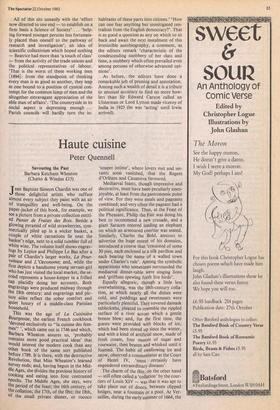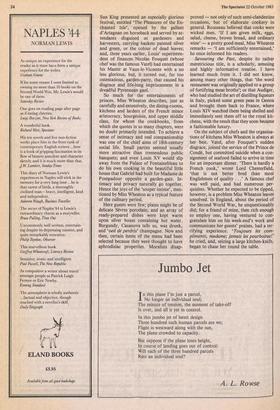Haute cuisine
Peter Quennell
Savouring the Past
Barbara Ketcham Wheaton (Chatto & Windus £15) Barbara Ketcham Wheaton (Chatto & Windus £15)
Jean Baptiste Simeon Chardin was one of those delightful artists who suffuse almost every subject they paint with an air of tranquillity and well-being. On the paper-jacket of this book, for example, we see a picture from a private collection entitl- ed Panier de Fraises des Bois. Beside a glowing pyramid of wild strawberries, sym- metrically piled up in a wicker basket, a couple of white carnations lie near the basket's edge, next to a solid tumbler full of White wine. The volume itself shows engrav- ings by Lepice and Philippe Le Bas after a Pair of Chardin's larger works, La Pour- voleuse and L 'Oeconome; and, while the first depicts a handsome young servant-girl Who has just visited the local market, the se- cond represents a house-keeper in a frilled cap placidly doing her accounts. Both engravings were produced midway through the 18th century; and engravings and pic- ture alike reflect the sober comfort and quiet luxury of a middle-class Parisian household.
This was the age of La Cuisiniere Bourgeoise, the earliest French cookbook 'devoted exclusively to "la cuisine des fem- ales" ', which came out in 1746 and which, Barbara Wheaton assures us, 'probably contains more good practical ideas' that would interest the modern cook than any Other book of the same sort published before 1789. It is there, with the destructive Revolution, that Miss Wheaton's learned survey ends; and, having begun in the Mid- dle Ages, she divides the previous history of cooking and eating into four contrasted epochs. The Middle Ages, she says, were the period of the feast; the 16th century, of the collation; the 17th, of the fete; the 18th, of the small private dinner, or rococo
`souper intime', where lovers met and ser- vants soon vanished, that the Regent d'Orleans and Casanova favoured.
Mediaeval feasts, though impressive and decorative, must have been peculiarly unen- joyable, at least from the gastronomic point of view. For they were meals and pageants combined; and very often the pageant had a political significance. Thus, at the Feast of the Pheasant, Philip the Fair was doing his best to recommend a new crusade, and a giant Saracen entered leading an elephant on which an armoured courtier was seated. Similarly, Charles the Bold, anxious to advertise the huge extent of his domains, introduced a course that 'consisted of some 30 pies, each enclosed in a silk pavilion and each bearing the name of a walled town under Charles's rule'. Among the symbolic apparitions who sometimes surrounded the mediaeval dinner-table were singing lions and 'griffons spewing forth live birds'. Equally allegoric, though a little less overwhelming, was the 16th-century colla- tion, at which nearly all the dishes were cold, and puddings and sweetmeats were particularly plentiful. They covered damask tablecloths, pleated to resemble the rippled surface of a river across which a gentle breeze blew; and, for the first time, the guests were provided with blocks of ice, which had been stored up since the winter, and with a kind of artificial snow, made of fresh cream, four ounces of sugar and rosewater, then beaten and whisked until it foamed. The habit of swallowing ice and snow, observed a commentator at the Court of Henri IV, 'must certainly have engendered extraordinary diseases'. The charm of the fete, on the other hand — still often called a 'collation' by the cour- tiers of Louis XIV — was that it was apt to take place out of doors, between clipped hedges, near a fountain or a pool. At Ver- sailles, during the early summer of 1664, the
Sun King presented an especially glorious festival, entitled 'The Pleasures of the En- chanted Isle', opened by the gallant d'Artagnan on horseback and served by at- tendants disguised as gardeners and harvesters, carrying baskets painted silver and green, or the colour of dead leaves; and, three years earlier, Louis' superinten- dent of finances Nicolas Fouquet (whose chef was the famous Vatel) had entertained his Master at Vaux-le-Vicomte with a no less glorious, but, it turned out, far too ostentatious, garden-party, that caused his disgrace and life-long imprisonment in a dreadful Pyrennean gaol.
So much for the entertainments of princes. Miss Wheaton describes, just as carefully and extensively, the dining-rooms, kitchens and larders of the French minor aristocracy, bourgeoisie, and upper middle class, for whom the cookbooks, from which she quotes in so many chapters, were no doubt primarily intended. To achieve a sense of intimacy and real companionship was one of the chief aims of 18th-century social life. Small parties seemed usually more attractive than tremendous public banquets; and even Louis XV would slip away from the Palace of Fontainebleau to do his own cooking in the beautiful little house that Gabriel had built for Madame de Pompadour opposite a garden-gate. In- timacy and privacy naturally go together. Hence the joys of the `souper intime', men- tioned by Miss Wheaton as a typical feature of the culinary period.
Here guests were few; plates might be of delicate Sevres porcelain; and an array of ready-prepared dishes were kept warm upon silver boxes containing hot water. Burgundy, Casanova tells us, was drunk, and 'oeil de perdrix' champagne. Now and then, certain items of the menu had been selected because they were thought to have aphrodisiac properties. Moralists disap- proved — not only of such semi-clandestine occasions, but of elaborate cookery in general. Rousseau believed that cooks were wicked men. 'If I am given milk, eggs, salad, cheese, brown bread, and ordinary wine' — a pretty good meal, Miss Wheaton remarks — 'I am sufficiently entertained,' he once informed his readers.
Savouring the Past, despite its rather meretricious title, is a scholarly, amusing and highly informative treatise. I have learned much from it. I did not know, among many other things, that 'the word restaurant was originally applied to a group of fortifying meat broths'; or that Audiger, who had studied the art of distilling liqueurs in Italy, picked some green peas in Genoa and brought them back to France, where Louis XIV watched them being shelled and immediately sent them off to the royal kit- chens, with the result that they soon became a fashionable luxury.
On the subject of chefs and the organisa- tions of kitchens Miss Wheaton is always at her best. Vatel, after Fouquet's sudden disgrace, joined the service of the Prince de Conde, but committed suicide when a con- signment of seafood failed to arrive in time for an important dinner. 'There is hardly a French cook,' wrote Lord Chesterfield, 'that is not better bred than most Englishmen of quality ... ' A famous chef was well paid, and had numerous per- quisites. Whether he expected to be tipped, however, is a problem Miss Wheaton leaves unsolved. In England, about the period of the Second World War, he unquestionably did; for a friend of mine, then rich enough to employ one, having ventured to con- gratulate him on his week-end's work and communicate her guests' praises, had a ter- rifying experience. `Toujours les com- pliments, madame; jamais les pourboires!' he cried, and, seizing a large kitchen-knife, began to chase her round the table.















































 Previous page
Previous page